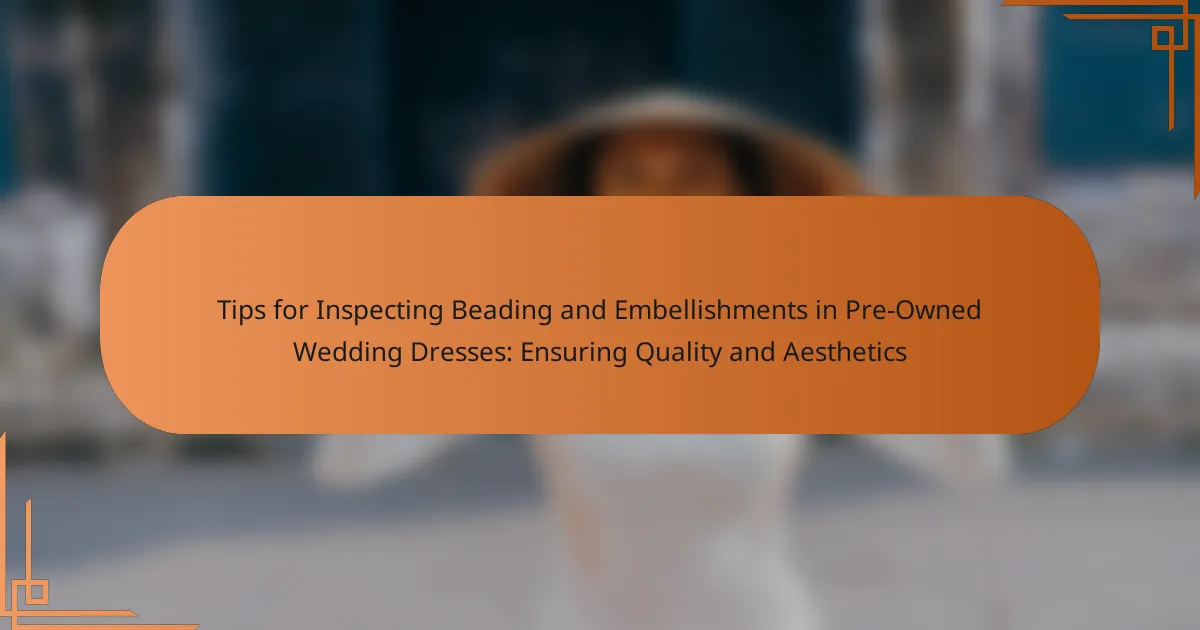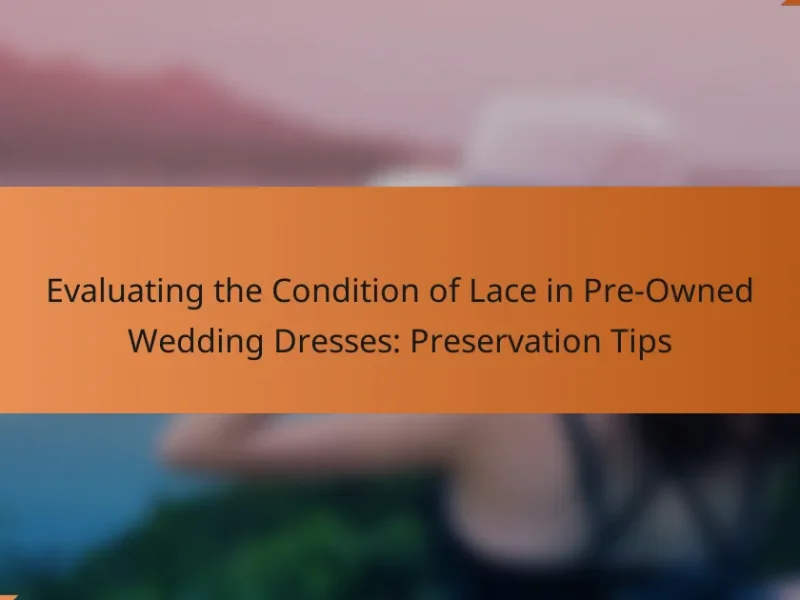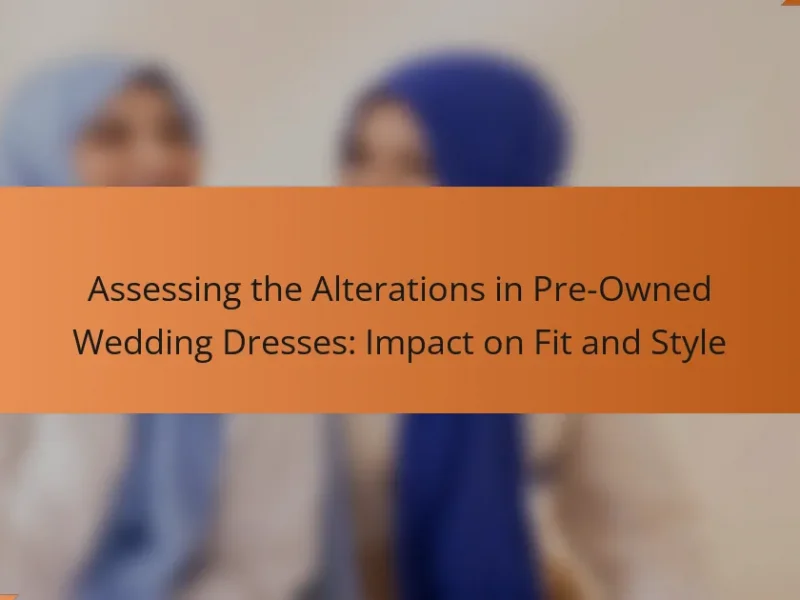The article focuses on inspecting beading and embellishments in pre-owned wedding dresses to ensure quality and aesthetics. Key considerations include checking for loose or missing beads, assessing stitching integrity, and examining for signs of wear or discoloration. It emphasizes the importance of symmetry and alignment in embellishments while considering the materials used, as some may be more susceptible to damage. Common issues like stains, tears, and odors are also addressed, highlighting their impact on the dress’s overall value and appearance. Techniques such as using a magnifying glass and natural light for detailed inspection are recommended for a thorough evaluation.
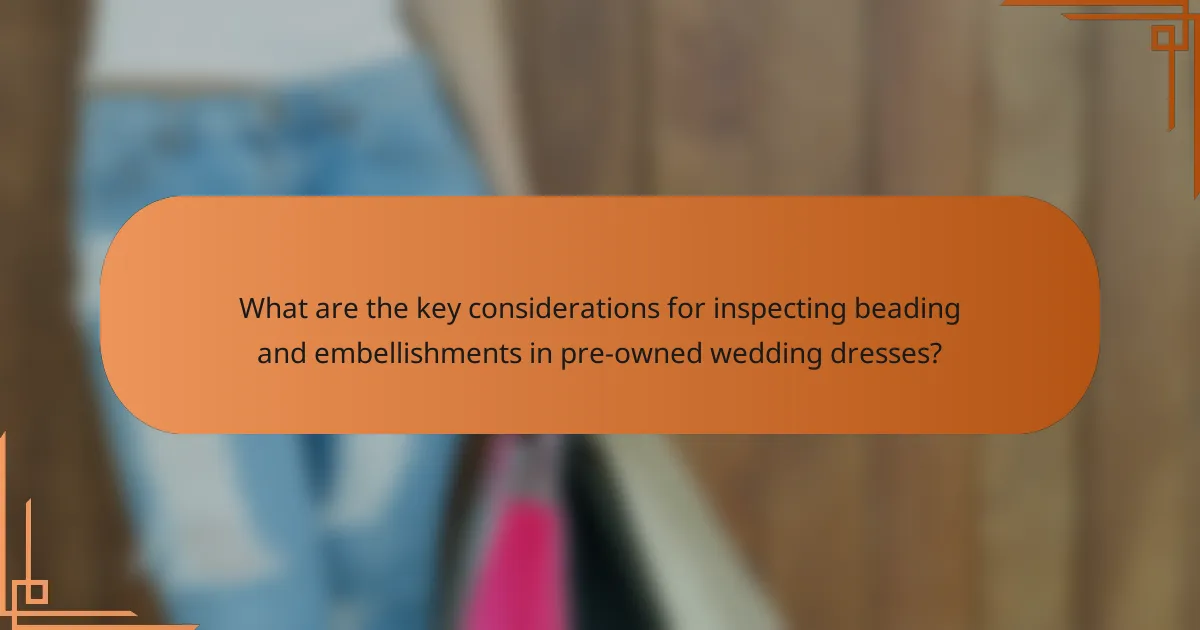
What are the key considerations for inspecting beading and embellishments in pre-owned wedding dresses?
Key considerations for inspecting beading and embellishments in pre-owned wedding dresses include checking for loose or missing beads. Examine the stitching integrity to ensure the embellishments are securely attached. Look for signs of wear or discoloration on the beads and fabric. Assess the overall symmetry and alignment of the embellishments for aesthetic appeal. Consider the type of materials used, as some may be more prone to damage. Inspect for any repairs or alterations that may affect the dress’s value. Finally, ensure that the embellishments complement the overall design of the dress.
How do you assess the overall quality of beading and embellishments?
Assess the overall quality of beading and embellishments by examining their craftsmanship, durability, and visual appeal. High-quality beading should have uniformity in size and shape. Check for secure attachment to the fabric. Inspect for any loose or missing beads, which indicates poor quality. Look for consistent spacing and alignment of embellishments. Evaluate the materials used; premium beads are often made from glass or crystal rather than plastic. Consider the overall design; intricate patterns usually signify higher craftsmanship. Lastly, assess how the embellishments complement the dress’s style, enhancing its aesthetic appeal.
What specific signs of wear should you look for in beading?
Look for frayed threads, loose beads, and discoloration in beading. Frayed threads indicate potential weakness in the stitching. Loose beads may fall off, affecting the overall appearance. Discoloration suggests exposure to light or moisture, compromising the material. Additionally, check for missing beads, which can create an uneven look. Inspect for scratches or dents on beads, especially if they are made of delicate materials. These signs of wear can impact the dress’s aesthetic and durability.
How can you determine if the embellishments are securely attached?
To determine if the embellishments are securely attached, gently tug on each embellishment. If it does not move or come off, it is likely secure. Inspect the stitching around each embellishment for any loose threads. Tight, even stitching indicates proper attachment. Look for signs of wear or fraying on the fabric surrounding the embellishments. This can indicate stress points. Additionally, check the underside of the embellishments for any visible glue or adhesive. Secure embellishments typically have minimal adhesive exposure. Finally, consider the overall condition of the dress; well-maintained dresses often have securely attached embellishments.
Why is the condition of beading and embellishments important for aesthetics?
The condition of beading and embellishments is crucial for aesthetics because it directly impacts the visual appeal of a garment. Well-maintained beading enhances the overall design and elegance of a wedding dress. Conversely, damaged or missing embellishments can detract from its beauty and value.
Aesthetic quality is often judged by the intricate details present in a dress. For instance, sparkling beads can catch light and create a stunning effect. This can elevate a simple design to one that is luxurious and eye-catching.
Research has shown that consumers often prioritize visual elements when choosing garments. A study by the Fashion Institute of Technology indicated that embellishments significantly influence purchasing decisions. Thus, the condition of these elements is essential for maintaining the dress’s attractiveness and market value.
How do beading and embellishments impact the overall look of the dress?
Beading and embellishments significantly enhance the overall look of a dress. They add texture, depth, and visual interest. This decorative detail can transform a simple garment into a statement piece. Beading often catches light, creating a shimmering effect that draws attention. Embellishments can also convey a sense of luxury and elegance. For instance, intricate beadwork can elevate the sophistication of a wedding dress. Additionally, they can reflect personal style and thematic elements of the event. The placement and design of these features can influence the silhouette and flow of the dress. Overall, beading and embellishments play a crucial role in defining the aesthetic appeal of a dress.
What role do embellishments play in the dress’s value?
Embellishments significantly enhance a dress’s value. They contribute to the overall aesthetic appeal and uniqueness of the garment. Intricate beading or embroidery can indicate higher craftsmanship. High-quality embellishments often signal a more expensive production process. This can increase the perceived worth in the eyes of buyers. Additionally, certain embellishments may reflect current fashion trends, further boosting value. Dresses with well-maintained embellishments typically command higher resale prices. Therefore, the presence and condition of embellishments are critical factors in determining a dress’s market value.
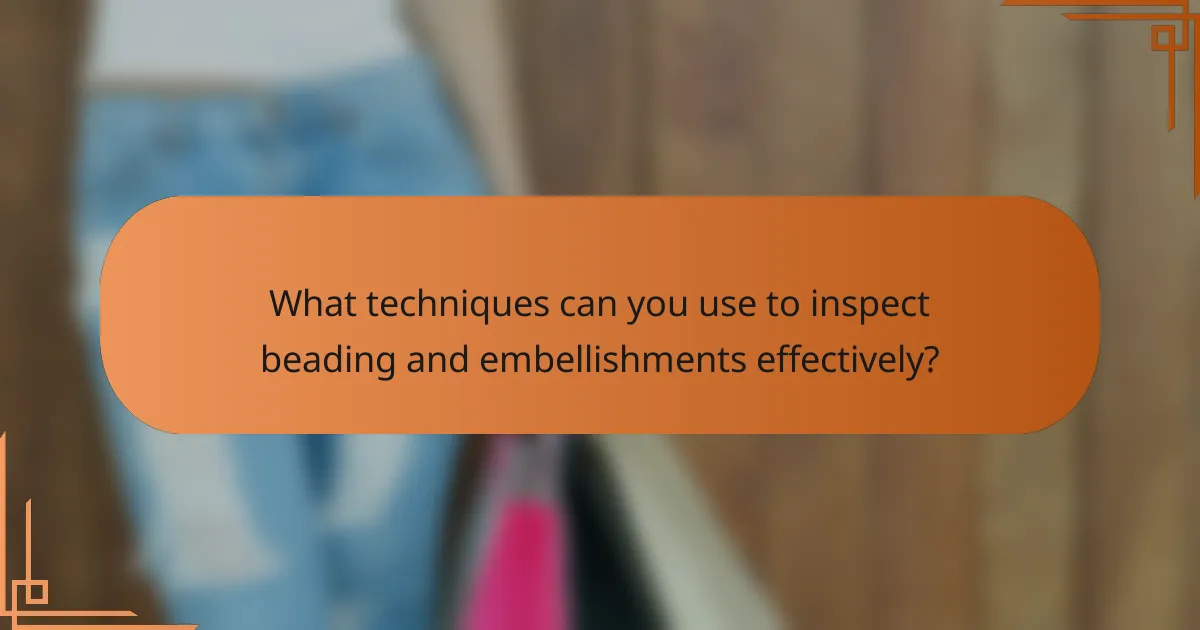
What techniques can you use to inspect beading and embellishments effectively?
Use a magnifying glass to inspect beading and embellishments closely. This technique helps identify any flaws or damage. Check for loose beads and secure stitching. Examine the placement and alignment of embellishments for consistency. Assess the quality of materials used, such as glass versus plastic beads. Look for signs of wear or discoloration. Utilize natural light to enhance visibility of details. Document any issues for reference during purchase decisions.
How can you use lighting to enhance your inspection process?
Using proper lighting enhances the inspection process by illuminating details effectively. Bright, focused lighting reveals imperfections in beading and embellishments. Natural light is ideal for accurate color assessment. LED lights provide consistent brightness without heat damage. Adjustable lighting angles help identify flaws from different perspectives. Shadows can obscure defects, so eliminate them by using multiple light sources. A well-lit area increases the likelihood of detecting inconsistencies. Proper lighting ultimately ensures a thorough and accurate inspection of wedding dress quality and aesthetics.
What types of lighting are best for examining details?
Natural daylight is the best type of lighting for examining details. It provides an even distribution of light, reducing shadows and enhancing color accuracy. LED lighting is also effective, as it offers a bright and consistent illumination. Using a light with a high Color Rendering Index (CRI) above 90 is ideal. This quality ensures the colors appear true to life. Additionally, a focused light source can help highlight specific areas, revealing intricate details. Soft diffused lighting minimizes harsh contrasts and allows for better visibility of textures. These lighting types enhance the ability to inspect beading and embellishments thoroughly.
How does lighting affect the perception of color and quality?
Lighting significantly impacts the perception of color and quality in objects. Different lighting conditions can alter how colors appear to the human eye. For example, natural daylight reveals true colors more accurately than artificial lighting. Incandescent bulbs can cast a warm hue, changing the appearance of colors. Fluorescent lights often create a cooler tone, which can make colors look different than intended. Quality can also be perceived differently under varying lighting; imperfections may become more visible in bright light. Studies show that lighting can influence consumer behavior, affecting purchasing decisions based on perceived quality. Understanding lighting conditions is essential for accurately assessing the aesthetics of beading and embellishments in pre-owned wedding dresses.
What tools can assist in the inspection of beading and embellishments?
Magnifying glasses and jeweler’s loupes assist in the inspection of beading and embellishments. These tools provide close-up views of intricate details. They help identify any defects or loose beads. Lighted magnifiers enhance visibility in low-light conditions. Tweezers aid in handling delicate embellishments without damage. A fabric ruler measures spacing and alignment of beads accurately. A lint roller removes dust and debris from the surface. These tools ensure thorough inspection and maintain the quality of the embellishments.
Which magnifying tools are most effective for detailed inspection?
Magnifying tools most effective for detailed inspection include jeweler’s loupes, handheld magnifiers, and digital microscopes. Jeweler’s loupes typically offer 10x to 30x magnification, allowing for close examination of intricate details. Handheld magnifiers are versatile and can provide various levels of magnification, often ranging from 2x to 10x. Digital microscopes can magnify objects up to 200x or more, providing a clear view on a screen. These tools help identify flaws in beading and embellishments. The use of proper lighting enhances visibility, making inspections more accurate.
How can a fabric swatch help in evaluating embellishments?
A fabric swatch can help in evaluating embellishments by providing a tangible reference for texture and color. It allows for direct comparison between the fabric and the embellishments. This comparison helps determine if the embellishments complement the fabric’s appearance. A swatch can also reveal how the fabric interacts with different embellishment materials. For example, certain beads may look different against various fabric types. Additionally, a swatch can assist in assessing the weight and drape of the fabric. These factors influence how embellishments will sit on the dress. Overall, a fabric swatch is essential for ensuring cohesive design and aesthetic quality.
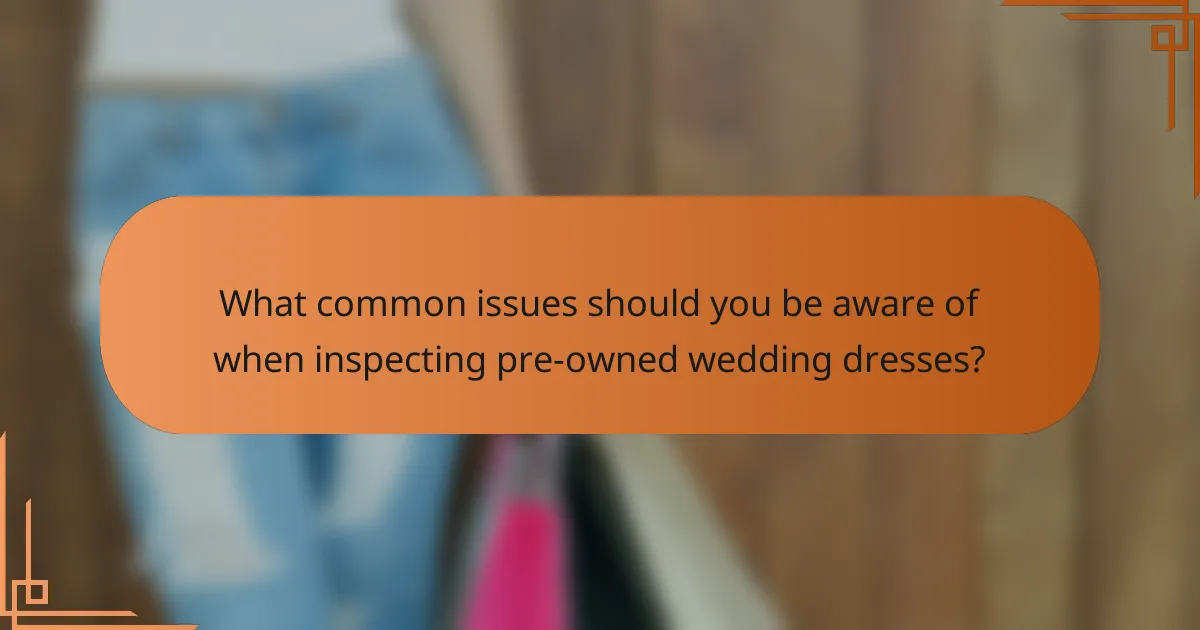
What common issues should you be aware of when inspecting pre-owned wedding dresses?
Common issues to be aware of when inspecting pre-owned wedding dresses include stains, tears, and discoloration. Stains can occur from food, makeup, or body oils, and may be difficult to remove. Tears can compromise the dress’s integrity and may require professional repairs. Discoloration often results from exposure to light or improper storage, affecting the dress’s overall appearance. Additionally, check for missing or damaged embellishments, as they can detract from the dress’s beauty. Lastly, inspect for odors that may indicate mildew or other damage. These factors are crucial for ensuring the quality and aesthetics of the dress.
What are the most frequent problems found in beading and embellishments?
The most frequent problems found in beading and embellishments include missing beads, loose threads, and discoloration. Missing beads can create uneven patterns and affect the overall appearance. Loose threads may lead to further damage or falling off of embellishments. Discoloration often results from exposure to light or improper cleaning methods. Other issues can include fraying fabric around the embellishments and tarnished metal components. These problems can significantly impact the quality and aesthetics of pre-owned wedding dresses. Regular inspection helps identify these issues early, ensuring the dress maintains its beauty.
How can discoloration or fading affect your purchase decision?
Discoloration or fading can significantly influence your purchase decision regarding pre-owned wedding dresses. Buyers often perceive discoloration as a sign of wear, potentially lowering the garment’s value. Fading may also affect the overall aesthetic appeal, making the dress less desirable. For instance, a white dress that has yellowed may not match the wedding theme. Buyers may also worry about the dress’s fabric integrity if fading is present. Additionally, discoloration can indicate exposure to light or improper storage. Therefore, assessing these factors is crucial before committing to a purchase.
What should you do if you find loose or missing embellishments?
If you find loose or missing embellishments, you should first assess the extent of the issue. Examine the area to determine if the embellishments can be reattached or need replacement. If they are loose, secure them with fabric glue or sew them back in place. For missing pieces, source matching embellishments from fabric stores or online retailers. It is important to choose high-quality materials to maintain the dress’s aesthetic. If unsure about repairs, consult a professional tailor or seamstress. They can provide expert advice and ensure the dress remains in good condition.
What are the best practices for ensuring quality in your purchase?
Examine the dress thoroughly before purchasing to ensure quality. Check for any signs of wear, such as fraying or discoloration. Inspect the beading closely for loose or missing pieces. Ensure that embellishments are securely attached and not damaged. Look for any stains or marks that could affect the dress’s appearance. Verify the integrity of the fabric by feeling for softness and checking for tears. Request a detailed history of the dress to understand its previous use. These practices help confirm the dress’s condition and overall quality.
How can you negotiate repairs or adjustments with sellers?
To negotiate repairs or adjustments with sellers, first identify specific issues with the item. Clearly communicate these concerns to the seller. Provide evidence such as photographs or detailed descriptions of the problems. Suggest reasonable solutions, such as price reductions or repair commitments. Be polite yet firm in your requests. Understand the seller’s perspective to foster cooperation. Research similar items to support your negotiation position. This approach increases the likelihood of a successful outcome.
What are the steps to take if you encounter significant defects?
Identify the significant defects in the wedding dress. Document the defects with clear photographs. Contact the seller immediately to report the issues. Request a resolution, such as repair, replacement, or refund. Review the seller’s return policy to understand your options. If necessary, escalate the matter to a consumer protection agency. Keep all correspondence for future reference. Follow up to ensure the issue is resolved satisfactorily.
The primary entity of this article is pre-owned wedding dresses, specifically focusing on the inspection of beading and embellishments. Key considerations for inspection include checking for loose or missing beads, assessing stitching integrity, and evaluating the overall aesthetic quality and condition of the embellishments. The article provides techniques for effective inspection, such as using proper lighting and magnifying tools, and highlights common issues like discoloration and loose threads that may affect the dress’s value. It emphasizes the importance of maintaining the quality of beading and embellishments to enhance the overall look and marketability of the dress.
